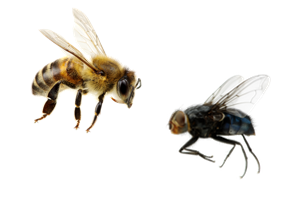Bees and Flies

Flies have been reproducing on earth for thousands of years and almost every individual can attest to swatting and shooing the pesky little insect. Flies are located throughout many regions and facilities, but they are mainly located near/in food establishments which can be potentially harmful for humans. Flies transmit pathogenic fungus, virus and bacterium through their vectors causing roundworms, pinworms, tapeworms, salmonella, typhoid fever, hepatitis, and various other illnesses for humans and animals; therefore sanitation is crucial in order to control the organism. There any many types of flies and identifying them is necessary in order to locate the source/access.
The following is helpful information on flies:
- Millions of organisms live in and on flies
- There are thousands of fly species
- Flies live all over the world
- Flies destroy our food source beginning with the harvesting stage
- Flies have a short gestation period producing thousands of offspring
- Flies have a significantly short life duration spanning from a few days to a couple of months
Bees mainly feed on pollen and nectar. Most of the extraction is used to feed the larvae. Bees have a long tongue (proboscis) that easily allows them to extract nectar from plants and flowers. One third of human food supply counts on pollination, which is mostly due to the work of bees. Bees have annual colonies that last for approximately one year. The colony dies in the fall with only the newly produced queens surviving the winter. (this does not apply to honeybees)
Both Bees and Wasps can sting, a defense mechanism; however, some species are more aggressive than others. When they sting, they inject protein venom which usually causes a variation of painful side effects for the victim. Bees and wasps can be hard to control at times because bee/wasp nests can be difficult to locate. The first step in controlling the infestation is to identify the type of bee or wasp and then attempt to trace the nest based upon the knowledge of the species. Nests are typically found in attics, under overhangs, and in the ground. Wherever the nests are located, they are treated accordingly in order to control the infestation.
